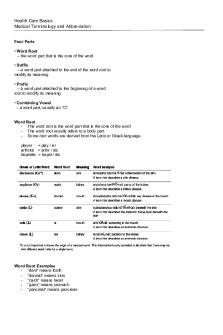Joint Movement Terms PDF

| Title | Joint Movement Terms |
|---|---|
| Author | taylor christofi |
| Course | Anatomy and Physiology I |
| Institution | Bergen Community College |
| Pages | 2 |
| File Size | 66.1 KB |
| File Type | |
| Total Downloads | 88 |
| Total Views | 141 |
Summary
Dr.Betsey A&P Joints/movement terms & explanations...
Description
Joint Movement Terms Abduction (abduct, take away) movement in the coronal plane that moves a limb laterally away from the body Adduction (add, bring together) movement in the coronal plane that moves a limb medially toward or across the midline of the body Circumduction circular motion of the arm, thigh, hand, thumb, or finger that is produced by the Rotation (left or right) movement of a bone around a central axis (arm at the shoulder joint or the thigh at the hip joint) moves anterior surface of the limb away from the midline of the body Depression (open mouth) downward (inferior) motion of the scapula or mandible Elevation (close mouth) upward (superior) motion of the scapula or mandible Protraction (away) anterior motion of the scapula or mandible Retraction (in) posterior motion of the scapula or mandible Dorsiflexion (heel down, toes pointed up) movement at the ankle, top of the foot toward the anterior leg (shin) Plantar Flexion (toes down, heel up) foot movement at the ankle in which the heel is lifted off of the ground Inversion (toes turned in) foot movement, bottom of the foot is turned toward the midline Eversion (toes turned out) bottom of the foot is turned laterally, away from the midline Extension (midline/neutral) movement in the sagittal plane that increases the angle of a joint (straightens the joint); motion involving posterior bending of the vertebral column or returning to the upright position from a flexed position Flexion (flex, forward from midline)
movement in the sagittal plane that decreases the angle of a joint (bends the joint) Hyperextension (extend, beyond the midline) excessive extension of joint, beyond the normal range of movement Lateral Flexion (right lateral flexion RLF, left lateral flexion LLF) bending of the neck or body toward the right or left side Pronated Position (thumb away from body, thumb toward body) forearm position in which the palm faces backward Supinated Position forearm position in which the palm faces anteriorly (forwards), anatomical position Supination (thumb toward body > thumb away from body) forearm motion that moves the palm of the hand from the palm backward to the palm forward position Pronation (thumb toward body > thumb away from body) forearm motion that moves the palm of the hand from the palm forward to the palm backward position...
Similar Free PDFs

Joint Movement Terms
- 2 Pages

Joint- Arrangements
- 13 Pages

Joint Arrangements
- 13 Pages

Joint Enterprise
- 4 Pages

Terms
- 8 Pages

Joint Venture
- 18 Pages

Joint Arrangement
- 21 Pages

Cotter Joint
- 8 Pages

Propaganda Movement
- 11 Pages

Terms
- 12 Pages

Essay-Terms - Innominate Terms
- 4 Pages

Acct3011 Joint Operations
- 7 Pages
Popular Institutions
- Tinajero National High School - Annex
- Politeknik Caltex Riau
- Yokohama City University
- SGT University
- University of Al-Qadisiyah
- Divine Word College of Vigan
- Techniek College Rotterdam
- Universidade de Santiago
- Universiti Teknologi MARA Cawangan Johor Kampus Pasir Gudang
- Poltekkes Kemenkes Yogyakarta
- Baguio City National High School
- Colegio san marcos
- preparatoria uno
- Centro de Bachillerato Tecnológico Industrial y de Servicios No. 107
- Dalian Maritime University
- Quang Trung Secondary School
- Colegio Tecnológico en Informática
- Corporación Regional de Educación Superior
- Grupo CEDVA
- Dar Al Uloom University
- Centro de Estudios Preuniversitarios de la Universidad Nacional de Ingeniería
- 上智大学
- Aakash International School, Nuna Majara
- San Felipe Neri Catholic School
- Kang Chiao International School - New Taipei City
- Misamis Occidental National High School
- Institución Educativa Escuela Normal Juan Ladrilleros
- Kolehiyo ng Pantukan
- Batanes State College
- Instituto Continental
- Sekolah Menengah Kejuruan Kesehatan Kaltara (Tarakan)
- Colegio de La Inmaculada Concepcion - Cebu



